This website is an archive from 2016
This site was actively maintained from 2006 to 2016. Since then I have kept it online for historical interest, but have made no further updates. Much of the information in these pages is now incorrect or obsolete.
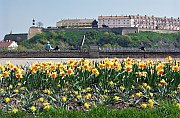
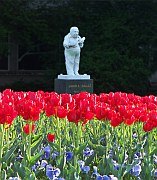
Flowers in Novi Sad
Vojvodina
Serbia's northern province of Vojvodina is geographically simple but culturally complex. It is the southernmost part of the Great Pannonian Plain, a land of broad, meandering rivers and fertile fields. A long period of Austro-Hungarian rule ensured that it has a more pronounced Central European atmosphere than the rest of Serbia. As a result of the Empire's encouragement of immigration, the province has an unusually diverse array of languages and cultures.
Novi Sad
Novi Sad is the capital of the Vojvodina region and Serbia's second-largest city (although Niš is apparently catching up). Like Belgrade it is built on the banks of the Danube and has a hilltop fortress, but in many other respects it is quite different from the capital - its spacious avenues have a more relaxed (or sleepier!) atmosphere than Belgrade's narrow and bustling streets. Novi Sad is often visited as a day trip from Belgrade, but it's worth considering a longer stay.
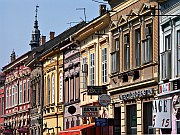
Dunavska Street
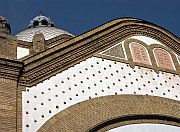
Synagogue
The heart of Novi Sad is the wide open space of Trg Slobode, surrounded by late 19th century buildings. The City Hall on the south side of the square faces the Roman Catholic "Cathedral", which in fact is merely a parish church. It's a neo-gothic structure similar to those encountered frequently in parts of Europe to the north of Novi Sad, but hardly at all in more southern regions. Frequent travellers in the former Yugoslavia will not be surprised to learn that the sculpture gesticulating towards the church is by Ivan Meštrović. Heading north from the square will bring you to the Bishop's Palace, Orthodox Cathedral, and colourful Dunavska Street.
The city centre has several museums and galleries and numerous religious buildings of various denominations. My favourite is the Synagogue, an impressively large and curvaceous structure to the west of the centre. Although no longer used for its original purpose (it is currently a concert hall) the building is in good condition and the Hebrew inscriptions are clearly visible.
As you explore the city you can't fail to see the Petrovaradin Citadel on the other side of the river. It covers a large area and you could spend a long time wandering around the battlements, some of them overgrown with grass and flowers, and enjoying the views of the Danube and the centre of Novi Sad. If you have travelled a lot in France you may recognise the touch of the architect Vauban. The barracks now house the City Museum, craft shops, artists' studios, and a restaurant. There is a huge complex of tunnels underneath the citadel - they were closed when I visited but I believe the museum sometimes organises tours. The quiet streets of Petrovaradin huddle below the citadel to the north. It's well worth having a look around - the narrow lanes and muted, earthy colours form an interesting contrast with the airy open spaces of Novi Sad itself.
One of the things I like best about Novi Sad is the way the river seems to be integrated into the life of the city - a rarity in the Balkan countries, where many cities seem to turn their backs on their rivers. The bank of the Danbue is a good place to enjoy an ice cream and admire the elaborate flower displays and views of the fortress. Just south of the centre is an area of parkland popular with strolling locals escaping from the hurly-burly of urban life - such as it is in Novi Sad. The riverside path leads to Štrand, Novi Sad's city beach, said to be one of the nicest on the Danube.
Novi Sad hosts a variety of fairs and festivals, but the most famous is undoubtedly the EXIT Music Festival held in July. The vast spaces of the Petrovardin Citadel are put to good use as a variety of international acts play on multiple stages.
Practicalities
The train station and long-distance bus station are located beside each other about 15 minutes' walk north-west of the centre. You should never have to wait long for a bus to Belgrade - the fastest ones via the motorway (autoput) take less than 1.5 hours. Trains are also a good option for getting to Belgrade (2 hours), or north to Subotica (1.5 hours) and on to Hungary. A local bus station very close to the centre serves nearby villages. Novi Sad is a good base for visiting the other attractions of Vojvodina described below (although Belgrade could also serve this purpose).
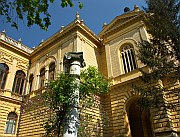
Patriarchate, Sremski Karlovci
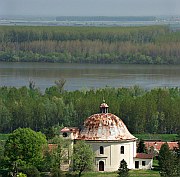
Peace Chapel and Danube
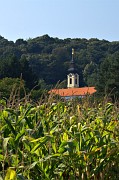
Novo Hopovo, Fruška Gora
Sremski Karlovci
The small town of Sremski Karlovci is located 11km from Novi Sad, where the wooded slopes of the Fruška Gora meet the Danube. Once an important town, for the last hundred years history seems to have passed it by, leaving its charming historical core undisturbed by the ugly modern buildings that detract from many Serbian towns.
The elongated tree-lined main square, in typical Vojvodina style, has both an Orthodox Cathedral and a Catholic church. The Cathedral of St Nicholas is an elegant twin-spired building with a particularly elaborate iconostasis. The adjoining Patriarchate has an attractive little garden round the back. Also look out for the neo-Byzantine High School (Gymnasium)building at the southern end of the square, and the Lower Church a short walk to the south-east. The latter is dwarfed by the plane tree in its grounds, said to be one of the oldest in Europe.
South of the centre, the circular Peace Chapel commemorates the signing of the Treaty of Karlowitz in 1699. The negotiations between the Holy Alliance and the Ottoman Empire apparently marked the introduction of the "round table" to the world of diplomacy. The chapel itself was built much later, and is currently in poor condition. To the west of the chapel is a hillside cemetery with good views of the town and the Danube plain.
I have been told that drinking from the Four Lions fountain in the main square guarantees not only that you will return to Sremski Karlovci, but that you will marry someone from the area. I'm still waiting...
Practicalities
Frequent buses to Sremski Karlovci run from the local bus station in central Novi Sad. Fairly frequent non-express buses between Novi Sad and Belgrade via Inđiaj also stop here, as do a handful of slow trains, so it's quite easy to visit as a daytrip from Belgrade. The Tourist Information office on the main square is unusually well equipped by provincial Serbian standards and can provide a detailed map in English.
Fruška Gora
Fruška Gora is a long ridge of low hills running east-west to the south of Novi Sad. Although it reaches heights of only 500 metres, the hills add welcome variety to the flat relief of Vojvodina. The higher parts are covered with dense forest, while the south-facing slopes are planted with vineyards and orchards. These southern valleys also shelter more than a dozen monasteries, of which the best known are Krušedol and Novo Hopovo. Most of the monasteries were founded between the 16th and 18th centuries, long after the great mediaeval institutions found further south in Serbia.
If you are travelling around Serbia, you may find that neither the scenery nor the monasteries of Fruška Gora are as memorable as their counterparts in the south of the country. Nevertheless if you happen to be in the Vojvodina region, an excursions through this bucolic landscape makes for a very pleasant day out.
Practicalities
It's easiest to explore the hills with your own transport, especially if you get hold of a tourist map of the Fruška Gora National Park, which is widely available in Serbia. If you like hiking, and don't obsess about seeing every single monastery, you can see a lot on foot - the same tourist map will come in useful for navigating the multitude of marked hiking trails that criss-cross the range. A few long distance buses pass Iriški Venac, right at the top of the ride; much more frequent buses run from Novi Sad to settlements on the northern fringe of the hills, including Sremski Karlovci (see above), Sremska Kamenica, and Beočin.
My own full day of walking in the area began in Sremski Karlovci, with a short walk along a minor road to the recreation area at Stražilovo, followed by a climb to the main ridge. I then descended the southern side of the ridge to Stari Hopovo, a quiet clearing with a lovely little church undergoing reconstruction. A short walk past plum trees and vineyards took me to Novo Hopovo, a large Baroque ensemble enclosing a church that recalls the earlier Byzantine style. A fairly steep climb led to the large monument at Iriški Venac, from where I followed a valley down to the outskirsts of Sremska Kamenica. I even found a bus waiting at the boundary of the National Park, allowing me to convince myself that I had planned the whole thing to the minute.
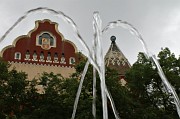
Town Hall, Subotica
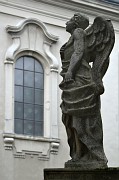
Cathedral, Subotica
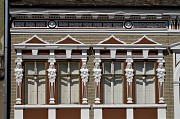
Vršac
Subotica
If Subotica is your first taste of Serbia after crossing the nearby Hungarian border, you won't experience much of a culture shock. Subotica has strong historical, linguistic, and architectural ties to Serbia's northern neighbour.
A century ago Subotica was apparently something of a boom town, and just after the First World War it was the largest city in the newly created Yugoslavia - difficult to believe today. The town centre still displays the visual hallmark of those prosperous decades, and aficionados of secessionist architecture will want to spend a couple of hours exploring the small grid of central streets; I suspect that few visitors will find much to detain them for longer.
Subotica's centrepiece is the extravagantly decorated and turreted Town Hall. It was built in 1910 and has been provoking mixed reactions ever since. "Unusually imaginative", say the enthusiasts; "gaudy and tasteless", say the detractors. The clock tower is open to visitors, but only once a day. If your timing is better than mine you'll have the chance to enjoy views of the town and have a look at the interior. The Town Hall is also home to one of the most discreet and understated McDonalds in Central Europe, which is ironic, as discretion and understatement are not qualities anyone would associate with the building itself.
Subotica's other Art Nouveau attractions include a ceramic fountain in front of the Town Hall, some whimsical mercantile facades along Korzo, and the very pretty Rajhl Palace (now an art gallery). The large synagogue must once have been an impressive sight but is now in poor condition. The Catholic Cathedral and the nearby Monument to the Victims of Fascism, in their different ways, present austere contracts to all the fin-de-siecle frivolity. The latter is generally described as "socialist-realist", although I'm not sure if its representation of war as an activity undertaken by very muscular, very naked men can truly be described as realistic.
As you walk around Subotica you may notice that many signs appear in three languages, with Hungarian and Croatian (Latin script) joining the usual Serbian (Cyrillic script). This is one of the few places in Serbia where you will see the Croatian word "Kolodvor" on a bus station.
There are frequent buses from Subotica to Novi Sad (2 hours), many of which continue to Belgrade (24 daily, 3.5 hours). Trains cover the same route, but less frequently; two of these trains continue to Budapest and Vienna. There are also a few local trains to Szeged, just over the Hungarian border.
Vršac
Vršac is a medium-sized town in the Banat region, close to the Romanian border. Although it doesn't have any unmissable sights, it is a pleasant place in which to enjoy many of the characteristic features of towns in Vojvodina: spacious streets and squares, Hapsburg architecture, and churches catering for a variety of denominations in a variety of architectural styles. Many of the buildings are brightly painted, and the place seemed to me to be more prosperous than many towns of similar size in Serbia.
If you have spent some time in northern Serbia and are beginning to tire of the sheer flatness of it all, you'll be relieved to find that Vršac is the proud possessor of a genuine hill. Paths lead up to a ruined tower that overlooks the town. Looking south from the tower you will see vineyards curving around the sunny slopes; to the north, the Pannonian plain stretches to an indistinct horizon somewhere in the heart of Central Europe. Shady walking trails lead eastwards into the Vršac hills, an outpost of the Carpathian range that reaches heights over 600 metres - positively Alpine by the standards of Vojvodina.
Vršac has good bus links to Novi Sad, and more frequent and faster connections to Belgrade (about 30 per day, 2 hours or less). Trains are much less convenient.
More photos of Vojvodina in my Serbia Galleries